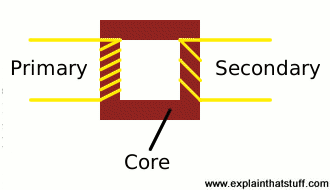A transformer is based on a very simple fact about electricity: when a fluctuating electric current flows through a wire, it generates a magnetic field (an invisible pattern of magnetism) or "magnetic flux" all around it. The strength of the magnetism (which has the rather technical name of magnetic flux density) is directly related to the size of the electric current. So the bigger the current, the stronger the magnetic field. Now there's another interesting fact about electricity too. When a magnetic field fluctuates around a piece of wire, it generates an electric current in the wire. So if we put the second coil of wire next to the first one, and send a fluctuating electric current into the first coil, we will create an electric current in the second wire. The current in the first coil is usually called the primary current and the current in the second wire is (surprise, surprise) the secondary current. What we've done here is pass an electric current through empty space from one coil of wire to another. This is called electromagnetic induction because the current in the first coil causes (or "induces") a current in the second coil. We can make electrical energy pass more efficiently from one coil to the other by wrapping them around a soft iron bar (sometimes called a core):

To make a coil of wire, we simply curl the wire round into loops or ("turns" as physicists like to call them). If the second coil has the same number of turns as the first coil, the electric current in the second coil will be virtually the same size as the one in the first coil. But (and here's the clever part) if we have more or fewer turns in the second coil, we can make the secondary current and voltage bigger or smaller than the primary current and voltage.
One important thing to note is that this trick works only if the electric current is fluctuating in some way. In other words, you have to use a type of constantly reversing electricity called alternating current (AC) with a transformer. Transformers do not work with direct current (DC), where a steady current constantly flows in the same direction.
Step-down transformers
If the first coil has more turns than the second coil, the secondary voltage is smaller than the primary voltage:

This is called a step-down transformer. If the second coil has half as many turns as the first coil, the secondary voltage will be half the size of the primary voltage; if the second coil has one-tenth as many turns, it has one-tenth the voltage. In general:
Secondary voltage ÷ Primary voltage = Number of turns in secondary ÷ Number of turns in primary
The current is transformed the opposite way—increased in size—in a step-down transformer:
Secondary current ÷ Primary current = Number of turns in primary ÷ Number of turns in secondary
So a step-down transformer with 100 coils in the primary and 10 coils in the secondary will reduce the voltage by a factor of 10 but multiply the current by a factor of 10 at the same time. The power in an electric current is equal to the current times the voltage (watts = volts x amps is one way to remember this) so you can see the power in the secondary coil is theoretically the same as the power in the primary coil. (In reality, there is some loss of power between the primary and the secondary because some of the "magnetic flux" leaks out of the core, some energy is lost because the core heats up, and so on.)
Step-up transformers
Reversing the situation, we can make a step-up transformer that boosts a low voltage into a high one:

This time, we have more turns on the secondary coil than the primary. It's still true that:
Secondary voltage ÷ Primary voltage = Number of turns in secondary ÷ Number of turns in primary
and
Secondary current ÷ Primary current = Number of turns in primary ÷ Number of turns in secondary
In a step-up transformer, we use more turns in the secondary than in the primary to get a bigger secondary voltage and a smaller secondary current.
Considering both step-down and step-up transformers, you can see it's a general rule that the coil with the most turns has the highest voltage, while the coil with the fewest turns has the highest current.

No comments:
Post a Comment